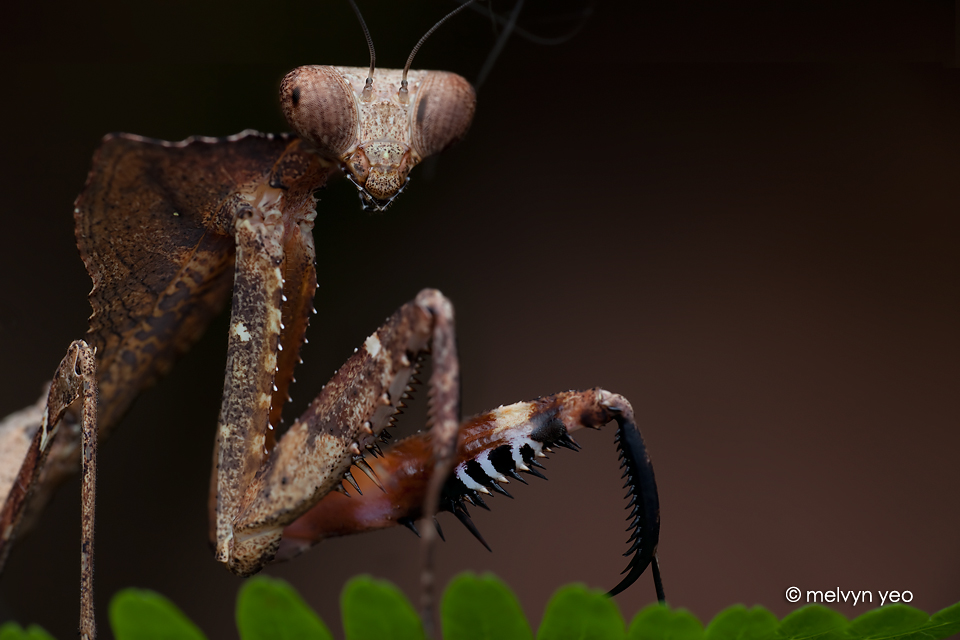ShopDreamUp AI ArtDreamUp
Deviation Actions

Wallpapers
If you love wallpapers in different styles, you are in the right place. We offer wallpapers that you have never seen anywhere before, (mostly for phones). Support my work by contributing to my tip jar. Help me stay motivated to publish more artwork so you can access exclusive artwork! Thank you.
$5/month
Suggested Deviants
Suggested Collections
You Might Like…
Featured in Groups
Description
A posing mantis  Taken at night in Singapore.
Taken at night in Singapore.
Quote from en.wikipedia.org/wiki/Mantis
Mantises have two grasping, spiked forelegs ("raptorial legs") in which prey items are caught and held securely. In most insect legs, including the posterior four legs of a mantis, the coxa and trochanter combine as an inconspicuous base of the leg; in the raptorial legs however, the coxa and trochanter combine to form a segment about as long as the femur, which is a spiky part of the grasping apparatus (see illustration). Located at the base of the femur are a set of discoidal spines, usually four in number, but ranging from zero to as many as five depending on the species. These spines are preceded by a number of tooth-like tubercles, which, along with a similar series of tubercles along the tibia and the apical claw near its tip, give the foreleg of the mantis its grasp on its prey. The foreleg ends in a delicate tarsus made of between four and five segments and ending in a two-toed claw with no arolium and used as a walking appendage.[8]
The mantis thorax consists of a prothorax, a mesothorax, and a metathorax. In all species apart from the genus Mantoida, the prothorax, which bears the head and forelegs, is much longer than the other two thoracic segments. The prothorax is also flexibly articulated, allowing for a wide range of movement of the head and forelimbs while the remainder of the body remains more or less immobile. The articulation of the neck is also remarkably flexible; some species of mantis can rotate the head nearly 180 degrees.
Mantises may have a visual range of up to 20 metres. Their compound eyes may comprise up to 10,000 ommatidia. The eyes are widely spaced and laterally situated, affording a wide binocular field of vision) and, at close range, precise stereoscopic vision. The dark spot on each eye is a pseudopupil. As their hunting relies heavily on vision, mantises are primarily diurnal. Many species, however, fly at night, and then may be attracted to artificial lights. Nocturnal flight is especially important to males in search of less-mobile females that they locate by detecting their pheromones. Flying at night exposes mantises to fewer bird predators than diurnal flight would. Many mantises also have an auditory thoracic organ that helps them to avoid bats by detecting their echolocation and responding evasively.[8]
Mantises can be loosely categorized as being macropterous (long-winged), brachypterous (short-winged), micropterous (vestigial-winged), or apterous (wingless). If not wingless, a mantis has two sets of wings: the outer wings, or tegmina, are usually narrow, opaque, and leathery. They function as camouflage and as a shield for the hind wings. The hind wings are much broader, more delicate, and transparent. They are the main organs of flight, if any. Brachypterous species are at most minimally capable of flight, other species not at all. The wings are mostly erected in these mantids for alarming enemies and attracting females. Even in many macropterous species the female is much heavier than the male, has much shorter wings, and rarely takes flight if she is capable of it at all.
The abdomen of all mantises consist of ten tergites with a corresponding set of nine sternites visible in males and seven visible in females. The slim abdomen of most males allows them to take flight more easily while the thicker abdomen of the females houses the reproductive machinery for generating the ootheca. The abdomen of both sexes ends in a pair of cerci.
Quote from en.wikipedia.org/wiki/Mantis
Mantises have two grasping, spiked forelegs ("raptorial legs") in which prey items are caught and held securely. In most insect legs, including the posterior four legs of a mantis, the coxa and trochanter combine as an inconspicuous base of the leg; in the raptorial legs however, the coxa and trochanter combine to form a segment about as long as the femur, which is a spiky part of the grasping apparatus (see illustration). Located at the base of the femur are a set of discoidal spines, usually four in number, but ranging from zero to as many as five depending on the species. These spines are preceded by a number of tooth-like tubercles, which, along with a similar series of tubercles along the tibia and the apical claw near its tip, give the foreleg of the mantis its grasp on its prey. The foreleg ends in a delicate tarsus made of between four and five segments and ending in a two-toed claw with no arolium and used as a walking appendage.[8]
The mantis thorax consists of a prothorax, a mesothorax, and a metathorax. In all species apart from the genus Mantoida, the prothorax, which bears the head and forelegs, is much longer than the other two thoracic segments. The prothorax is also flexibly articulated, allowing for a wide range of movement of the head and forelimbs while the remainder of the body remains more or less immobile. The articulation of the neck is also remarkably flexible; some species of mantis can rotate the head nearly 180 degrees.
Mantises may have a visual range of up to 20 metres. Their compound eyes may comprise up to 10,000 ommatidia. The eyes are widely spaced and laterally situated, affording a wide binocular field of vision) and, at close range, precise stereoscopic vision. The dark spot on each eye is a pseudopupil. As their hunting relies heavily on vision, mantises are primarily diurnal. Many species, however, fly at night, and then may be attracted to artificial lights. Nocturnal flight is especially important to males in search of less-mobile females that they locate by detecting their pheromones. Flying at night exposes mantises to fewer bird predators than diurnal flight would. Many mantises also have an auditory thoracic organ that helps them to avoid bats by detecting their echolocation and responding evasively.[8]
Mantises can be loosely categorized as being macropterous (long-winged), brachypterous (short-winged), micropterous (vestigial-winged), or apterous (wingless). If not wingless, a mantis has two sets of wings: the outer wings, or tegmina, are usually narrow, opaque, and leathery. They function as camouflage and as a shield for the hind wings. The hind wings are much broader, more delicate, and transparent. They are the main organs of flight, if any. Brachypterous species are at most minimally capable of flight, other species not at all. The wings are mostly erected in these mantids for alarming enemies and attracting females. Even in many macropterous species the female is much heavier than the male, has much shorter wings, and rarely takes flight if she is capable of it at all.
The abdomen of all mantises consist of ten tergites with a corresponding set of nine sternites visible in males and seven visible in females. The slim abdomen of most males allows them to take flight more easily while the thicker abdomen of the females houses the reproductive machinery for generating the ootheca. The abdomen of both sexes ends in a pair of cerci.
Image size
960x640px 321.24 KB
Make
Canon
Model
Canon EOS 5D Mark II
Shutter Speed
1/160 second
Aperture
F/16.0
Focal Length
100 mm
ISO Speed
100
Date Taken
Jan 12, 2014, 12:56:14 AM
Sensor Size
6mm
© 2014 - 2024 melvynyeo
Comments17
Join the community to add your comment. Already a deviant? Log In
That expression!! Magnificent photo! 































![Daring glare [brown mantis]](https://images-wixmp-ed30a86b8c4ca887773594c2.wixmp.com/f/c53e7f9a-f10e-484a-b434-a34c52ded0e8/db83tpj-1a13d7aa-53c6-4f3f-81a9-dd73411417cd.jpg/v1/crop/w_184)

